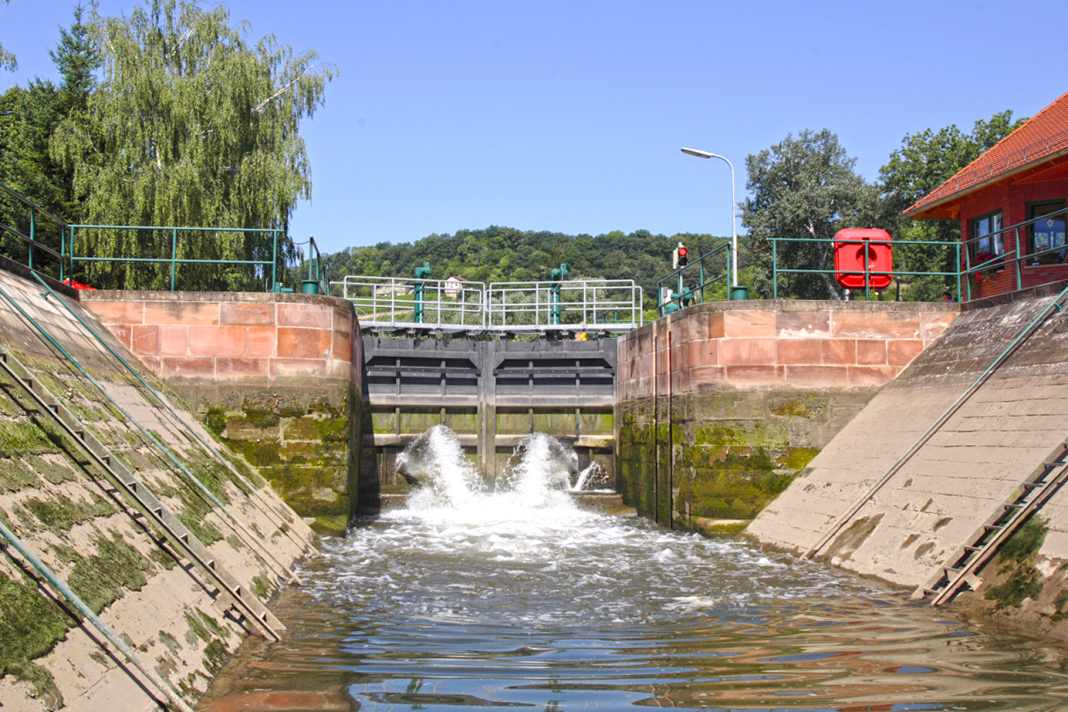




The purely physical functioning of a lock chamber is basically always the same, regardless of whether it is a small barge lock or a large shaft lock. The gate technology may differ, as may the way in which the water enters and leaves the chamber, but this does not change the basic principle - raising or lowering ships by changing the water level.
Let's first take a look at the lock itself: In simple terms, it consists of a chamber that can be closed watertight on both sides by gates. It also has lockable openings at both ends - so-called gates - which are used to regulate the water level in the chamber.
If it is at the level of the lower water, i.e. the lower end of the lock on the valley side, it is empty - as in the first illustration (upstream lock) in the gallery. Only in this state can the lower gate, as the lock gate is called at this point, be opened. Meanwhile, the upper gate at the other end of the chamber is firmly closed by the pressure of the higher upper water.
When do we speak of a mountain lock?
If the boats are to go up, this is called an uphill lock: once the boats have entered the chamber, the lower gate with its gates is closed first. The gates at the upper gate are then opened, water flows in and the chamber begins to fill.
The upper gate can only be opened once the water level has reached the level of the upper water and is fully equalised - the water pressure on it is too high before then. The boats in the chamber can now leave; the upstream lock is complete.
How does the valley lock process work?
In the valley, the process is exactly the opposite: the boats enter the full chamber through the open upper gate. The gates on the upper gate are then closed and the gate itself is closed immediately afterwards. The entire lock is now watertight. Now, however, the gates at the bottom gate open and the water flows out of the chamber into the underwater, where the current increases noticeably, especially in smaller locks - a clear sign that it is "going down inside". As soon as the water level is equalised on both sides of the lower gate, the gates open and the journey is free again.
While valley sluicing is usually quite calm and without much flow in the chamber, upstream sluicing can be much more turbulent, especially in older, smaller chambers. This depends on the one hand on the design of the lock and its drop height (i.e. the difference between upstream and downstream water) and on the other hand on how quickly the water flows into the chamber.
How should you behave during the lock?
If this happens very quickly, for example with the gates fully open, strong currents, whirlpools and uncomfortably short waves can form. It is then important to keep the boat as close to the chamber wall as possible. The best way to do this is to run the lines on a slip over a cleat. If, on the other hand, the boat is slipped "freehand", you are ill-prepared for sudden strong forces.
If the boat is pushed away from the chamber wall despite all efforts, you must also think about the other side of the boat, where there may be another boat. Fenders should therefore always be deployed on both sides before entering.
To reduce the force of the inflowing water, the gates of the upper gate are only partially opened at the beginning of the sluicing process - either automatically or manually. They are only opened fully when the chamber is at least half full.
Video: How to lock correctly
The light signals during locking
The light signals for entering locks are available in various combinations, the most common in Germany by far are shown here. As a general rule, no matter in which combination the lights are illuminated, red always means "Stop". Green alone means "clear ahead". The exit from the chamber is also often authorised with a green traffic light.






